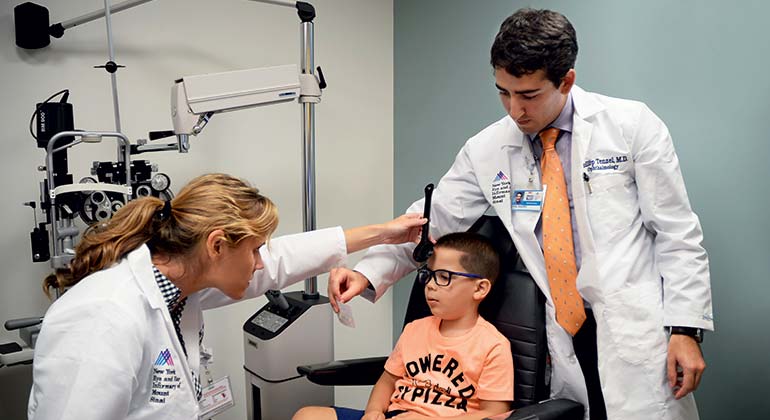
Eye Movement Disorders
The specialists of New York Eye and Ear Infirmary of Mount Sinai (NYEE) are highly skilled in treating a wide range of eye movement disorders in children, including the following:
Pediatric Strabismus
When a child’s eyes fail to line up and focus together on a single object, it results in a condition known as strabismus. Also called crossed eyes or “lazy eyes,” this misalignment occurs when the muscles in each eye are uncoordinated and thus unable to move the eyes together. Children with strabismus often have poor vision in one eye with limited depth perception.
The most common type of strabismus is esotropia, when one or both eyes turn inward toward the nose. Exotropia, another common type of strabismus, occurs when one or both eyes turn outward. Children who develop acute strabismus with no past history of the condition should be tested by their physician for hydrocephalus (the accumulation of excess fluid in the brain) or tumors. At NYEE, we also rely on observations from parents for signs and patterns of strabismus to help with our diagnosis.
It’s important that your child’s eyes be examined by an ophthalmologist if they don’t appear to be working in unison. If your family has a history of strabismus, that examination should be conducted by an eye professional earlier than age three.
How is Strabismus Treated?
The condition is commonly treated by an ophthalmologist through eyeglasses, patching to force the child to use the compromised eye, eye muscle exercises, surgery, or some combination of these. For children with the most severe forms of strabismus, surgery at an early age (recommended before the start of school) may be a safe and effective treatment. During the surgery—performed while the child is under general anesthesia—the eye muscles are either strengthened or weakened, depending on which direction the eye is turning. Though there are risks as in any surgery, recovery is usually quick with minimal discomfort afterwards.
Amblyopia
Amblyopia is the most common eye disorder in children. Also known as lazy eye, it occurs when one eye is not used sufficiently by the child to trigger the proper visual response in the brain. The result is poor vision in the affected eye, even with glasses. Amblyopia is commonly caused by strabismus (eye misalignment) or when one eye is more nearsighted, farsighted, or astigmatic then the other.
Because amblyopia may not have obvious symptoms, it is important that your child’s vision be checked at around three or four years of age. If recognized early, the condition usually responds well to treatment. If not detected until the child is older, treatment is much more difficult, and permanent vision loss can result.
How is Amblyopia Treated?
Amblyopia can be corrected by forcing the “lazy” eye to become more active. This is accomplished by covering the stronger eye with a patch, which is usually worn for a period of weeks or months. Your ophthalmologist will advise you on proper treatment.
Nystagmus
Nystagmus is characterized by involuntary, repetitive, and jerky movements of the eyes, which can impair vision and depth perception and even affect balance and coordination. Sometimes known as “dancing eyes,” this condition can be the sign of another eye or medical problem, such as congenital cataracts, strabismus, extreme nearsightedness or astigmatism, inflammation of the inner ear, or central nervous system diseases.
Nystagmus can develop at two to three months of age (infantile), between six months and three years of age, or later in childhood or adulthood (acquired). It is typically caused by a neurological problem that is present at birth or develops in early childhood.
How is Nystagmus Treated?
Eyeglasses and contact lenses may be prescribed by your ophthalmologist to improve vision, though they do not correct the underlying condition. Some types of nystagmus improve during childhood, and only rarely is surgery recommended. If other health conditions are involved, your ophthalmologist may refer you to the appropriate medical specialists for further evaluation.
Diplopia
When duplicate images of the same object are seen, it is known as diplopia, or double vision. In children, diplopia is rare, but may result from strabismus—the failure of both eyes to focus together on the same object. This can result in each eye viewing a separate image, which the brain is unable to fuse together into a single picture. Refractive error (poor focusing of light by the eye from myopia, hyperopia, or astigmatism) can also lead to double vision.
Sometimes double vision in children is relatively harmless, the result of fatigue or illness, which causes a temporary misalignment of the eyes. Other times, diplopia is more serious, and can be a sign of systemic disease. For that reason, it is important for an ophthalmologist to conduct a thorough examination to determine the cause and severity of the problem. This should include a complete medical history and advanced forms of testing.
How is Diplopia Treated?
Depending on the underlying cause, treatment may consist of eye patching, eye muscle exercises, eyeglasses, surgical straightening of the eyes, or some combination of these.
